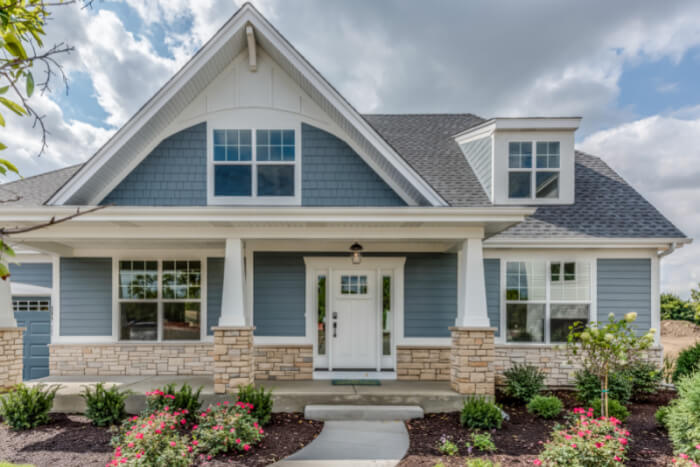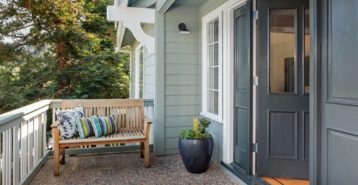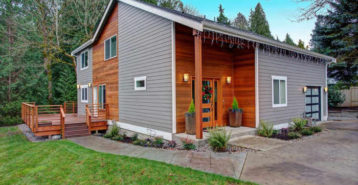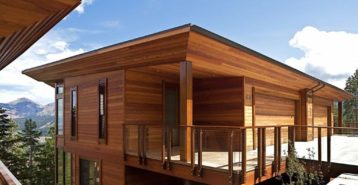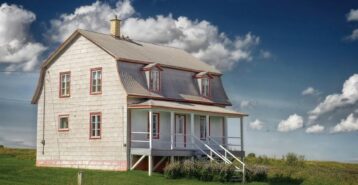Hardie Board Siding Installation
If you are looking to refresh the appearance of your home without breaking the bank, a Hardie board siding installation is a home improvement project to look into. Also known as Hardiplank siding or cement siding, this type of siding originated from James Hardie, giving it its most common name.
What is Hardie Board?
Hardie board is a very versatile siding that allows you to mimic the look of more expensive siding types without needing to pay for the real thing. As a form of fiber cement siding, it is made of cement, sand, and cellulose fibers, making it durable and long-lasting. Whether you want to create the look of cedar shingles, natural stone, or clapboard style siding, Hardie board siding has a solution for you at a more moderate cost with improved durability.
A new siding installation is one of the best mid-priced home improvement projects in which you can invest. Hardie board siding can earn you an 84% return on investment for your home’s overall resale value.
Hardie Board Siding Benefits
There is a lot to love about Hardie board siding. It is a product that you can expect to last the lifetime of your home with relatively low maintenance. It is also attractive in appearance and available in a wide variety of colors and textures to meet your home décor preferences.
Below are several benefits you will enjoy after installing this type of siding on your home:
Types of Hardie Board
While Hardie board is a type of fiber cement, it comes in several different styles. Homeowners can choose a Hardie board style based on the aesthetic and design they want for their home – whether it is Victorian, Colonial, modern, or Craftsman.
Here are a few popular Hardie board siding styles you can choose from:
- Hardie lap siding: The most popular Hardie board style, featuring horizontal laps in various textures and colors for a timeless design.
- Board and batten: Uses wide vertical planks with molding between boards for a rustic look, ideal for farmhouse or modern homes.
- Hardie textured panels: Wide panels and trims in various textures for a modern appearance.
- Hardie shingles: Mimic cedar or wood shakes but offer greater durability and longevity.
Hardie Board Siding Weight
One important factor to consider with Hardie board siding is its weight. It weighs about 300 pounds per 100 square feet, compared to 60-70 pounds for vinyl siding. Because of this, the labor and installation process is more complex and requires more resources than other siding materials.
Hardiewrap Siding Add-On
When installing Hardie Board, you will also have the option to install HardieWrap. It is a type of weather-resistant house wrap that can decrease your environmental footprint, while also saving you money on your monthly utility bills.
HardieWrap serves as both a water resistive barrier and as an air barrier. It is installed over the sheathing, beneath the exterior siding (cladding) to reduce water infiltration and air infiltration. It also allows potentially damaging water to escape from the building interior.
HardieWrap is typically available by the roll – typically 9 feet by 100 to 150 feet in size. You can expect each roll to cost around $200. Be sure to ask your contractor about whether or not your home needs a HardieWrap layer, and what the total add-on cost will be based on your home’s square footage.
Is Hardie Board Siding Eco-Friendly?
Hardie board is more environmentally sustainable than common siding types like vinyl, wood, and aluminum. It lasts the lifetime of your home, eliminating the need for replacement every decade and reducing landfill waste.
They are also committed to sustainability. It sources 90% of materials from regional suppliers, cutting carbon emissions from transportation. The company uses waste minimization and recycling technologies to support Zero to Landfill initiatives.
Hardiplank Maintenance Tips
Cleaning and maintaining the siding exterior of your home is key to preserving its beauty and durability. The extent and nature of maintenance will depend on the geographic location of your home, climate, and exposure of the building. Normal care and maintenance for Hardiplank includes:
- Clean siding every 6 to 12 months: Use a garden hose or low-pressure water spray to remove dirt and debris. For stubborn stains, apply mild detergent with a soft bristle brush.
- Clean out the gutters and downspouts: Regular gutter cleaning prevents blockages and overflows, reducing the risk of water damage to your siding.
- Reapply caulking as needed: Recaulk when signs of wear appear to keep moisture out of the wall cavity. Use caulks labeled as “permanently flexible” for best results.
- Trim back vegetation and shrubs: Keep landscaping away from siding to avoid damage and prevent sprinklers from saturating areas near the home.
Compare top-rated siding pros in your area.
Read real homeowner reviews, explore qualifications, and view promotions. Modernize makes it easy to browse professionals and find one that will be perfect for your project.
